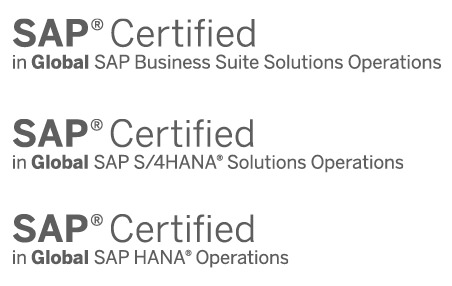Moving IT operations to the cloud is strategic in order to meet business objectives. Our CTO, Ricardo Casanovas, has summarised in a webinar how to approach a project to migrate SAP management systems, which are critical for many companies, to the Amazon Web Services (AWS) cloud.
Cloud computing is the basis of the digital transformation projects that the vast majority of companies around the world are tackling. These processes have accelerated in the last year and should have a clear purpose: to be a lever to help organisations achieve their business goals.
However, not all companies are able to leverage their cloud investment and successfully complete their projects when moving their critical systems to the cloud. As a leader in the migration of management systems to the public cloud, we have helped numerous companies of all sizes and industries successfully move their systems and workloads to the public cloud.
In a webinar (in Spanish) organised with the technology magazine Computing, Ricardo Casanovas, Vice President of SAP Products and Innovation, shared the methodologies and best practices to follow in order to achieve, regardless of the results sought, the maximum potential of a SAP system on the AWS platform.
Demystifying cloud computing, our expert stressed that the great contribution of the cloud is that it allows “the right technology to be available in the right place at the right time, through a unified management environment”. From there, each company must establish the cloud strategy that best suits its business needs and the objectives it has set itself, “which are the ones that should take precedence when choosing between the different cloud models – private, public or a hybrid format – in which resources are consumed under a pay-per-use model“.
Before choosing the option that best suits the business strategy, it is essential to “reflect” on what is best for the organisation, which will generally have to cover a series of business objectives, which are very common in most organisations, and which have to do with the following areas:
- Financial optimisation (controlling costs, generating savings, reducing the technology bill, moving towards a variable cost model, etc.).
- Acquisition of new capabilities.
- Improving IT infrastructure as a gateway to new functionalities and resources.
- And, finally, achieving a better competitive position in the market.
“All companies must do the exercise of defining their cloud strategy in line with their business objectives. It must decide which applications are to be migrated, which are not, which need to be modernised, which are to be moved to a software as a service (SaaS) format, which will go to a cloud infrastructure and which model. Each company has to select what best suits its situation and also what fits best with its vision for the future,” the CTO stressed.
This scenario of where the company wants to go is carried out in the selection and planning phase which, in his opinion, “is critical and for which there is no single path”.
However, our company’s experience over ten years has shown that organisations tend to take their first steps towards the cloud by deploying productivity applications and satellite support solutions, such as CRM or data analytics systems, which are areas in which the offering is very mature. “However, for solutions such as ERP, where the company’s financial data and operational management resides, there are more difficulties or less supply available to migrate to a 100% as a service environment,” said Ricardo Casanovas.
In these cases, he explained, the trend is to first evolve the infrastructure towards the cloud, then optimise the architecture of the management system that already resides in the new model and, finally, evolve it, integrating it with new services based on Big Data technologies, the Internet of Things, Machine Learning or Artificial Intelligence.
Migration scenarios
Following this approach, when moving systems or applications to the cloud, there are four main migration scenarios with very different motivations:
- Migrating from an application to a SaaS model. In this case, the company becomes a consumer of a solution, such as an office or collaboration suite, and does not have the capacity to make adaptations.
- Lift & Shift. In this scenario, the infrastructure is migrated, moving systems from an on-premise environment to the cloud and adopting a pay-per-use model that offers “practically infinite and global” capacity, he said.
- Replatform. This framework is used when a company wants to evolve its infrastructure platform and take advantage of the benefits of cloud architecture, adapting its applications. “Normally the first step is usually to do a ‘lift & shift’ and then delve into the advantages of the cloud model,” he added.
- Refactoring applications. This consists of reviewing the code of the applications themselves to assess whether it is worth re-deploying these programs considering that they are going to be deployed in the cloud. “It may be more effort and complexity but it offers the maximum benefits of the cloud model,” said the CTO.
Best practices
There are a number of phases that all companies should go through that are a compendium of best practices:
- Learn
- Invest in training. Acquire technical skills in new technologies to understand the path the company will take, even if it eventually delegates deployment and management to a third party.
- Take it one step at a time
- Start small and try before you use. Select non-critical applications.
- Don’t lose sight of the end horizon.
- Implement the new management model, because new areas of knowledge emerge that need to be managed and there will have to be an adaptation.
- Consolidate the management model
- When executing the migration plan, think about the details in order to reach the objectives more deeply.
- Many companies value the creation of a Cloud Centre of Excellence.
- Plan new migrations or deployments.
- Execute new deployments to migrate at scale.
- Iterate, measure, correct and iterate again.
By way of summary, Ricardo Casanovas stressed that “in our highly technological world we can say that change is a constant in our lives. New technologies emerge in the cloud that make new things possible, so we have to invest in training, be agile and have management processes prepared to implement these changes. And we always have to do this by aligning cloud strategy with business objectives, which also evolve over time”.
To close the session, he reminded the audience that the cloud is an “infinite” toolbox for carrying out any technology initiative, with pieces to build innovative solutions, which are within everyone’s reach with a minimum entry cost. “It really offers capabilities that are practically unattainable in a non-cloud environment because of the resources needed and the high cost,” he concluded.
If you want to know more about how we help our customers in their cloud migration projects, please click on this link. Also, on this page you can learn about the success stories of the companies that have trusted us.



